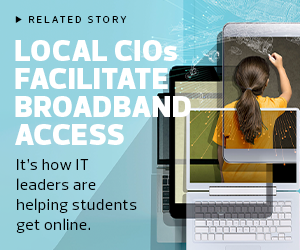What the Pandemic Revealed About Digital Equity
A year ago, government agencies, school districts and private businesses were busy snapping up every laptop and Chromebook they could get their hands on to support remote work. What many found out after they purchased those devices was that not everyone had equal access to high-speed broadband outside of school or the office.
Without access at home, residents who were laid off could not easily search for jobs online and would not be eligible for jobs that required remote work.
Government agencies have used federal funding and other sources of support to make investments over the past year in expanding deployments of fiber infrastructure. That points to the need for government agencies to think about improving digital equity as a long-term, sustained effort.
Digital equity should be pursued by state and local governments not simply for its own sake and for the fact that access to broadband is a prerequisite for much of modern life, but also because it can lead to better talent recruitment and expanded economic development.
MORE FROM STATETCH: How governments and schools are partnering on closing the digital divide.
The Long-Term Effects of Closing the Digital Divide
Across the country, state and local governments have made investing in broadband a priority during the pandemic, largely by relying on federal funding. Kansas is allocating $50 million to expand access to more than 70,000 households. Georgia is expanding broadband access across 18 counties to more than 80,000 households. Boone County, Ohio, is partnering with Cincinnati Bell to expand high-speed broadband access to every address in the county.
Despite these and similar efforts across the country, there is still a need for state and local governments to expand broadband access. A report released in February 2020 from the company BroadbandNow found the Federal Communications Commission’s estimate that 21 million Americans lack access to broadband actually undercounts the figure by 20 million.
In addition to making expanded broadband access an ongoing priority, government IT and civic leaders should also use this opportunity to think through lessons learned by a lack of access to broadband.
What are government agencies’ vulnerabilities? Which departments became squeaky wheels as a result? Can the government successfully support full-time remote work, or part-time hybrid work? Moving forward, the ability to support robust remote work could be seen as a perk for workers and may also allow governments to recruit from a broader and more diverse talent pool.
If governments are able to lay fiber and expand access to broadband, they will be able to compete with communities that have historically had more expansive broadband deployments. That will help attract not just government workers, but families, businesses and economic development as well. Businesses may be more willing to set up shop in areas with less expensive real estate costs if they know they have as reliable access to broadband as they would in a more expensive area.
The way forward is complicated and could largely be dictated by how much funding the federal government invests in broadband expansion over the next several years. Yet the need for that expansion is clearer than ever, and state and local governments have a role to play in helping their communities get online.
This article is part of StateTech’s CITizen blog series. Please join the discussion on Twitter by using the #StateLocalIT hashtag.












